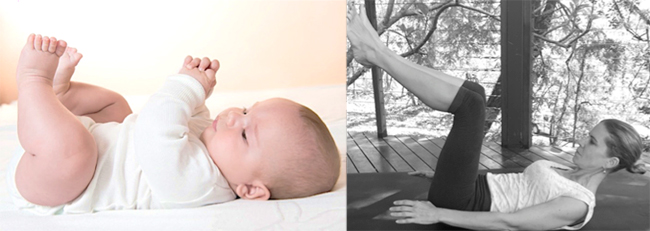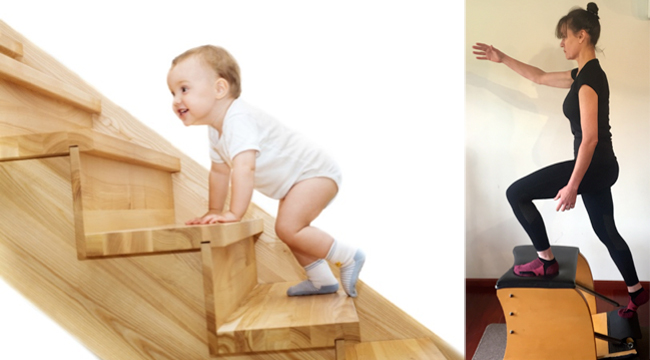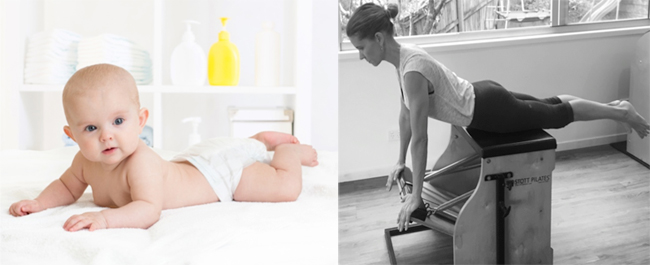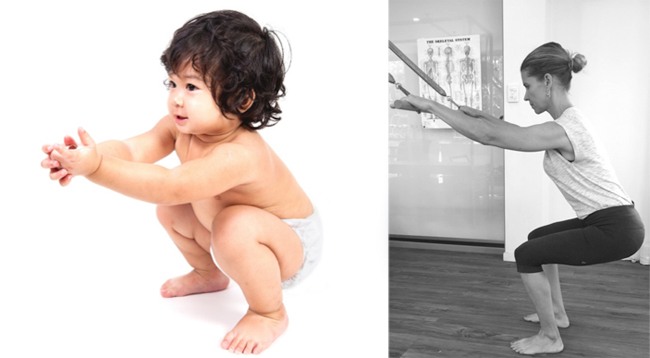
A Pilates Instructor’s Journey into Developmental Kinesiology
An article by Chris Lavelle
PAA Vice President
Romana’s Pilates, Certified Level IV
Principal Trainer, Pilates Alliance of Australasia
Certified DNS Exercise Trainer, Rehabilitation Prague School
In 2014, pain and dysfunction led me to look beyond traditional biomechanical models of movement, to a unique rehabilitation and exercise approach called Dynamic Neuromuscular Stabilisation (DNS).
DNS was developed by Professor Pavel Kolar at the Prague School of Rehabilitation. Kolar’s groundbreaking method builds on the pioneering work of other Prague school ‘greats’, in neurological development and movement rehabilitation (Professors Lewit, Janda, Vojta and Vele).[1]
DNS is based on the scientific principles of Developmental Kinesiology, which explains how movement patterns develop in a newborn baby.
In a healthy baby, the development of movement function goes hand in hand with the development of the musculoskeletal system and is under the control of the Central Nervous System (CNS). Consequently, all the joints and muscles are working together in perfect balance to create dynamic joint stability. There are no tight versus weak muscles and no compensations – agonists and antagonists are in perfect balance and joints are ‘centrated’ in an optimal position. Nor is there any strain or excessive effort, breathing is naturally relaxed.
I should have listened to Joe!
Throughout his written work, Joe constantly refers to developmental movement as the blueprint for a healthy body and mind. When I reflect back over my Pilates career, I am always curious as to why I never paid much attention to these constant references, or to the importance of the developmental process in correcting musculoskeletal dysfunctions in adulthood.
Have you ever closely and thoughtfully observed the movements of a newly-born babe? This constant desire for change in movement in babies is a manifestation of one of the many fundamental laws of nature – the law of action – which animals and human beings obey alike, if unhampered. Babies instinctual desire for action – constantly turning around, grasping for and holding on to objects within their reach, stretching and bending their little bodies, arms and legs; creeping on the floor.[2]
Even after I had a child of my own, I never thought to look more closely at her movement and development, other then to admire her cuteness and stellar progress in meeting developmental milestones. Little did I realize how important these developmental milestones were to improving movement in my self or my clients.
Why is Developmental Kinesiology important to Pilates instructors?
‘Posture follows movement like a shadow’ – Rudolph Magus, Physiology of Posture.
People come to Pilates to improve quality of life, enhance performance or aesthetics and recover from pain or injury. They have often been told they need to improve their posture, core stabilisation, strength, flexibility and co-ordination – the catchwords of our profession. What most people don’t realize is that posture, core strength and stability are all dynamic neuromuscular functions, that require an improvement in underlying movement patterns (motor control). Furthermore, most pain, dysfunction and deconditioning of the human body, is directly linked to insufficiencies in motor control – whether it be poor stabilisation, faulty breathing or poor joint alignment.
Joseph Pilates also wrote about this:
‘Incorrect habits are the responsible for most of our ailments’. [3]
So how do we go about influencing and improving motor control?
What does good stabilisation look like? What muscles create spinal and joint stability? What is the correct way to breathe? What is the ideal alignment of the spine or other joints in motion?
There are multiple schools of thought on all these topics! Unlike the clearly defined structural ‘norms’ in our anatomy texts, we do not have clearly defined norms for movement and posture. Or do we?
If we look, as Joseph Pilates did, at the ‘movements of the newborn babe’, developmental kinesiology shows us that the development of body posture begins at birth and goes hand in hand with the development of movement AND the maturation of our musculoskeletal system.
Development of body posture is one of the fundamental elements in the development of movement patterns and cannot be separated from the anatomical maturation of the musculoskeletal system.[4]
We don’t have to teach babies how to roll over, sit or crawl, because these motor programs are inborn in the CNS. All these movements and the muscle co-ordination required to achieve them, occur automatically and in a very specific sequence in the first years of life. With the maturation of the CNS, the baby’s structure and function keeps changing, as inbuilt motor programs shape posture and movement.
When babies are born they are immature – in both function and structure. For example, the shape of the hip, arch of the foot and curves of the spine all have to mature during normal development. Likewise, a newborn has no postural control, but from the end of the 1st month, the postural movement functions related to maturation of the CNS begin.
A healthy baby sequentially develops neuromuscular stability at rest and in motion, which allows for optimal development.
Development of movement function (also called motor or postural ontogenesis) is automatic and depends on the needs of the baby and its environmental stimulus. In other words, the baby’s motivation to move is related to its desire to get to positions where it can see/experience the world – it wants to look around, follow its mother’s voice, reach for an object etc.
In a normal baby the CNS ensures equal activation between agonists and antagonists in all these developmental positions. Because the muscles activated in each developmental position are continuously pulling on the structural growth plates, it is understandably critical that the pull is balanced to ensure ideal formation of the skeleton!
Stabilisation and movement in the first year of life
To fully understand the relevance of developmental kinesiology to Pilates instruction, it is necessary to first understand a little about the intricacies of neuro-physiological development during the first year of life. If you find the information in this next section overwhelming, you are not alone. It took me a good 6 months to wrap my head around the concepts I learnt in my first DNS course, but it was well worth it! So please stay with me to the end of the article, as hopefully my journey and application to Pilates, will provide some insights.
Sagittal stabilisation: The first 4.5 months of a baby’s life are spent learning to stabilise their body in a correct spinal curvature and setting the pelvis and chest in parallel alignment. The position and shape of the spine, chest and pelvis eventually reaches a neutral position around 3 months, as a result of coordinated muscle activity. This muscle activity allows for a subsequent increase in Intra Abdominal Pressure (IAP), which stabilises the lumbar spine from the front. As the baby continues to develop, there is: ‘balanced co-activation between the deep cervical flexors and spinal extensors in the cervical and upper thoracic region, as well as the diaphragm, pelvic floor, all sections of the abdominals and spinal extensors in the lower thoracic and lumbar region. The diaphragm, pelvic floor and TVA regulate IAP and provide anterior lumbo-pelvic postural stability’.[5]
Differentiation of muscle function: After sagittal stabilisaton is completed at 4.5 months, babies start to move off the sagittal plane and purposeful extremity movement begins. This involves two distinct movement functions in the extremities:
- Stepping (or reaching) – which is always activated in an open kinetic chain.
- Supporting (or pushing off) – which is always activated in a closed kinetic chain.
In the developmental process, both stepping and supporting functions are co-dependent with the stabilisation of the spine, chest and pelvis (sagittal stabilisation). They also have specific patterns of muscle pull, dictated by the CNS. In stepping or reaching the muscle pull is proximal – towards the center, whilst in support function, the muscle pull is distal, towards the supporting joint.
Both stepping and supporting functions are present in all phasic movement, however they appear in different upper/lower limb combinations, according to whether the ‘global’ movement pattern is ipsilateral or contralateral.
If the movement pattern is ipsilateral (turning/rolling/rotation) – the stepping and support functions happen on the same side. If the movement pattern is contralateral (crawling, walking) – the stepping and support functions happen on opposite sides.[6]
Yes, that is a lot of information to take in! Try re-reading it and consider for a moment the insight this clear and precise understanding of human movement can offer us as Pilates instructors. Now consider that Pilates apparatus also allow us to create semi-closed and semi-open chains, to further assist our clients in feeling and developing improved motor control!
Applying DNS principles to Pilates instruction
As Pilates practitioners, the science of Developmental Kinesiology and the exercise protocols of DNS, can enlighten and progress our teaching approach, giving us leading edge tools to facilitate improved movement in all our clients – including those seeking general fitness, recovery from injury, improved athletic performance, pre/post natal fitness etc.
Here are just a handful of the many concepts that I have taken from DNS and applied to my Pilates practice and instruction. These concepts have transformed the way I interpret and correct movement, the way I program my classes and most importantly, the way my clients move and feel.
Before a baby attempts to move, it first learns to stabilise its spine and establish an ideal relationship between trunk and pelvis. Stabilisation on the sagittal plane is essential for any phasic movement. All movement is preceded by stabilisation of body segments to provide balance, efficient coordination and stability through the entire kinetic chain.
Application: If we want to tap into the innate developmental patterns buried in the human brain, we must apply the same process to our adult clients. Sagittal stabilisation is my starting place for all new clients – and my foundational practice for all existing clients.
Contrary to common ‘core strength’ approaches, true or ‘deep’ core stability is not achieved through the strength of the abdominals, gluts or back muscles alone. It results from optimal intra-abdominal pressure regulation, requiring specific neuromuscular co-ordinaton patterns.[7] Stabilisation is achieved from the inside out,[8] with correct breathing ensuring adequate distribution of intra abdominal pressure and an ideal relationship between the muscles of the deep core.
Application: Core stability is NOT simply a muscle strengthening activity, it is a neuromuscular pathway. Corrective ‘neuromuscular’ stabilisation training is an essential foundation of any exercise method, including Pilates. Again, if we want to change movement function, we first have to influence our clients’ stabilisation strategy!
Sagittal (core) stabilisation is dependent upon the diaphragm’s ability to create sufficient Intra-Abdominal Pressure (IAP) to stabilise the spine. This ‘postural’ function of the diaphragm must be balanced with its first and fundamental function, respiration. Competition between postural and respiratory function of the diaphragm affects the quality of stabilisation and movement. During exercise, this competition can be seen in changes to breathing (holding breath, shallow breath, activation of auxiliary breathing muscles).
Application: If your client is not breathing correctly, it is physiologically impossible for them to activate the deep core and stabilise the spine and extremities. ‘If breathing is not normalised – no other movement pattern can be’. Karel LewitJoseph Pilates wasn’t joking when he said, ‘Before any real benefit can be derived from physical exercises, one must first learn how to breathe properly’.
According to studies by Kolar et al, IAP in adults can be disrupted by inadequate ‘postural’ function of the diaphragm, leading to compensatory action of the larger spinal extensors, an imbalance between upper and lower chest musculature and a less then ideal relationship between the ribcage and pelvis. This may contribute to increased compression of the spine, particularly strain on the lower back.[9][10]
At the age of 4.5 months, stabilisation of the spine, pelvis and chest in the sagittal plane is completed. This stabilisation pattern is then a precursor to all ‘dynamic’ movement that develops as the baby’s posture and structure matures.
Application 1: We can’t keep our clients in ‘cued’ or pre-empted stabilisation mode forever. Movement of the extremities in the global movement patterns (contralateral and ipsilateral) is necessary for the client to integrate new motor patterns into their every day activities and for the patterns to become part of their automatic postural function. Even if a client’s stabilisation is imperfect, as long as I can see improvements in breathing and the ability to regulate IAP, I get them moving and practicing their new skills in dynamic movement.
Application 2: Just like the baby, the client needs to practice, practice and practice – the same developmental patterns over and over for them to become automatic. The Pilates system of exercise is ideal for this kind of neuro-muscular training as the same patterns appear over and over in different exercises and on different apparatus, giving us the perfect playground! Joseph Pilates also recommended low repetitions (so there is no fatigue to brain/muscles) and to repeat the same movements every class, only adding more coordinated movements when the body is ready.[11]
Developmental Kinesiology shows us that ideal movement requires well centrated and balanced ‘support’ in all body segments. The support is the fixed stable base from which muscles can generate movement. [12]In daily life and in most upright Pilates exercises, support is at the feet and hands and sometimes on the shins, knees, or sit bones (in sitting). It can also be at the hip and shoulder in side lying (and a variety of other locations). ‘It is impossible to ensure correct breathing and stabilisation of the spine without optimal support function and it is impossible to achieve good support without good patterns of breathing and stabilization. The two are interdependent.’ [13] Correct support is also a necessity for the balanced co-activation of all other muscles involved in a movement pattern (kinetic chain).
Application: Often the muscles around common supporting joints have become dysfunctional and lost correct balance and co-ordination. Many clients have alignment and co-ordination dysfunctions in the feet, ankles, wrists and hands. These cannot be ignored and must be adequately addressed to allow dynamic stabilisation in Pilates exercises. De-centration at the supporting joint will result in movement compensations along the entire kinetic chain, leading to dysfunctional joint motion, altered core and extremity recruitment patterns, muscle imbalances and eventual wear and tear on joint structures.
Take the time to correct and practice optimal support in the hands, feet etc., in static unloaded positions. I ask my clients to feel the difference that centration of support can make to other joints in the kinetic chain and to their core activation.
Optimal muscle coordination and ‘muscle balance’ is genetically determined and begins automatically during CNS maturation. The balanced muscle function established during the developmental period allows for a neutral or centrated position of joints.[14] A ‘centrated’ joint gives the most effective mechanical advantage and is ideal for loading. The centrated or neutral joint position should therefore guide ideal movement blueprints. Once again we can see Joseph Pilates understanding of these concepts in the following statements ‘Contrology…allows equal muscle relaxation and tension’ and ‘True flexibility can be achieved only when all muscles are uniformly developed’. JP
Application: If we are to stimulate the brains ideal movement ‘blueprints’, through Pilates, our clients must be able to differentiate between the correct ‘centrated’ movement and the incorrect ‘decentrated’ movement. The client’s conscious feeling of the correct movement is critical and requires adequate body awareness. We can improve body awareness by improvement in cortical functions – such as the ability to activate/relax muscles, the ability to isolate movement, the timing of muscle activation, limb placement, spatial awareness, rhythm and gnostic functions.
Many of these functions are already priorities for Pilates instruction, but it is always good to remember that they are crucial to improving motor control. They are of equal importance as the development of muscular strength, tone or physical stamina.
The developmental of human movement follows a very specific sequence, with a gradual progression from proximal to distal support. Starting on the sagittal plane, the baby gradually progresses to dynamic movement on the transverse plane – first in posturally low positions such as side lying (from supine) and quadruped (from prone). As the CNS, musculoskeletal system and postural function develop, the baby moves into more upright and differentiated positions – eventually leading to side sitting, walking and squatting.Every developmental position can be seen as an exercise position, and therefore an opportunity to improve sagittal stabilisation, establish good quality of support and develop awareness of centrated joint positions and movements.
Application: Don’t ask your clients to walk before they can crawl! Follow the developmental sequence. This sequence is, unsurprisingly, clearly evident in the archival and classical order of Joseph Pilates’ original exercise system. His writings, archives and the elders, all express the method had a specific order. I.e. proximal to distal, low to high, with a gradual decrease in base of support and assistance from the apparatus.
Start with sagittal stabilisation, add undifferentiated limb movement and continue to progress to differentiated and higher positions. Remember that the more advanced the developmental position/Pilates exercise – the greater demand for stabilisation and dual function of the diaphragm! It is also important to ensure an equal balance of movement on all planes and a good balance of ipsilateral and contralateral patterns.
Summary
DNS offers us clear blueprints for dynamic posture, stabilisation and functional breathing, drawn from the study of the human musculoskeletal system from birth to maturation (developmental kinesiology).
A DNS approach to Pilates:
- allows us to train muscles in physiological function (purposeful movements)
- teaches clients to activate ideal stabilisation
- prevents repetitive strain injuries through improving joint centration
- enhances clients Pilates technique and results by improving stabilisation, body awareness and quality of movement patterns.
Want to learn more?
DNS exercise training for Pilates instructors course are held in Sydney regularly. Go to the PAA website, Approved Workshops for more details.
Click for more information on DNS
Photo Credits
Babies: Rehabilitation Prague School
Adults: Monique Telfer, Meta Pilates, Brisbane. Chris Lavelle
References:
[1] Crenshaw K, Liebenson C. Influence of Czech Techniques: A Historical Perspective, The Annual Publication of the Professional Baseball Athletic Trainers Society, 2009; 22(1)
[2] Pilates, J, Your Health. Bookmasters
[3] Pilates, J, Your Health. Bookmasters
[4] Kobesova A, Kolar P. Developmental Kinesiology: Three Levels of Motor Control in the Assessment and Treatment of the Motor System. , Journal of Bodywork and Movement Therapies. 2014;18(1):23-33.
[5] Kolar P. et al, Clinical Rehabilitation. Alena Kobesova, Rehabilitation Prague School, 2013.
[6] Kobesova A, Kolar P. Developmental Kinesiology: Three Levels of Motor Control in the Assessment and Treatment of the Motor System. , Journal of Bodywork and Movement Therapies. 2014; 18(1): 23-33.
[7] Frank C, Kobesova A, Kolar P. Dynamic Neuromuscular Stabilisation & Sports Rehabilitation, Int J Sports Phys Ther. , 2013 Feb;8(1): 62-73
[8] Lindgren, H. Core Stability from the inside out. 2011. www.hanslindgren.com/articles.
[9] Kolar P, Sulc J, Kyncl M, Sanda J, Cakrt O, Andel R, Kumagai K, Kobesova A. Postural function of the diaphragm in persons with and without chronic low back pain. J Orthop Sports Phys Ther. 2012; 42(4): 352-62
[10] Kolar P, Sulc J, Kyncl M, et al. Stabilizing function of the diaphragm: dynamic MRI and synchronized spirometric assessment. J Appl Physiol. 2010; 109:1064-1071.
[11] Pilates, J. Return to life through Contrology
[12] Kobesova A, Kolar P. Developmental Kinesiology: Three Levels of Motor Control in the Assessment and Treatment of the Motor System. , Journal of Bodywork and Movement Therapies. 2014; 18(1): 23-33.
[13] Jezkova, M. Prague School of Rehabilitation. 2014, DNS sport 2 course notes.
[14] Kobesova A, Kolar P. Developmental Kinesiology: Three Levels of Motor Control in the Assessment and Treatment of the Motor System. Journal of Bodywork and Movement Therapies. 2014; 18(1): 23-33.






Comments are closed.